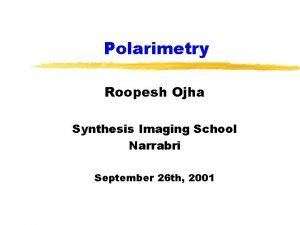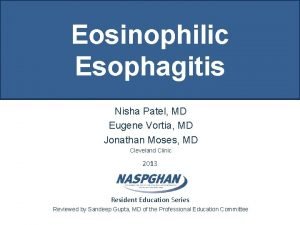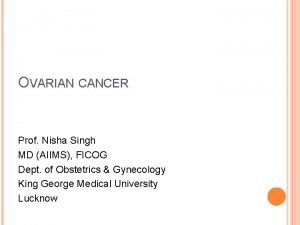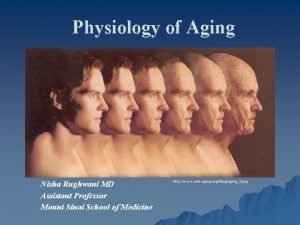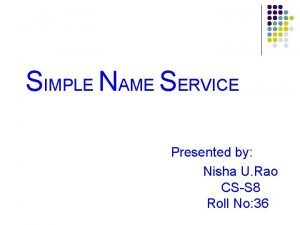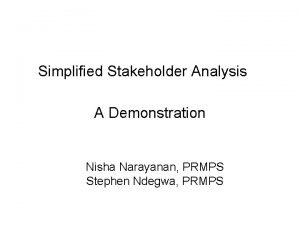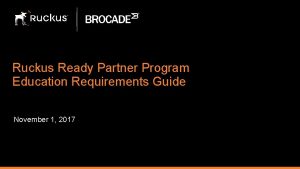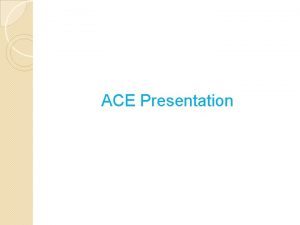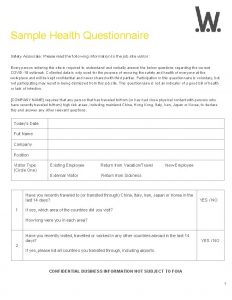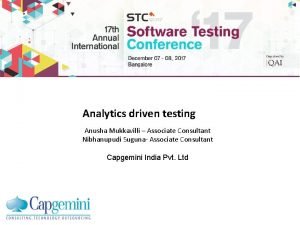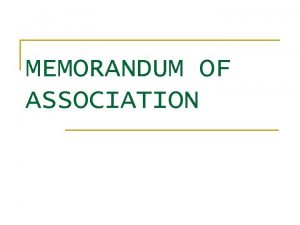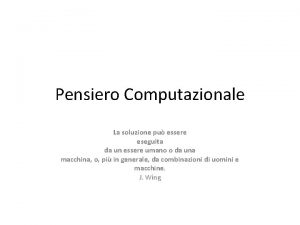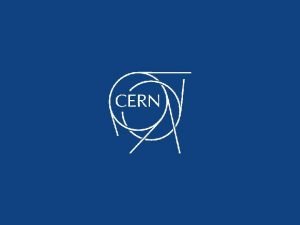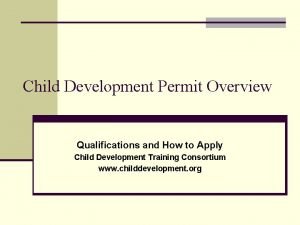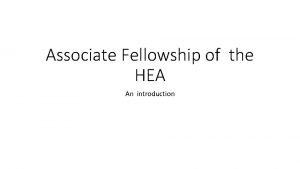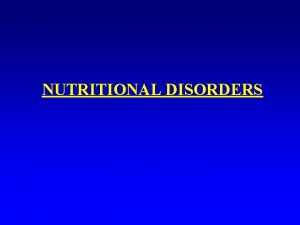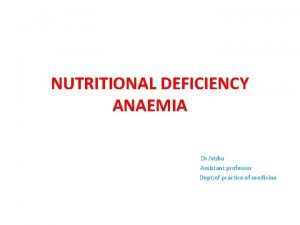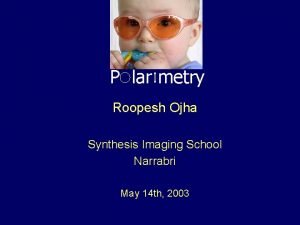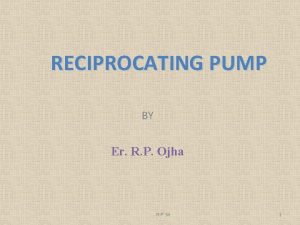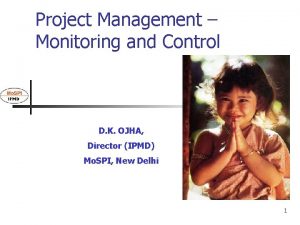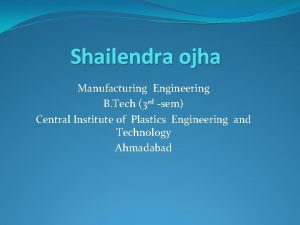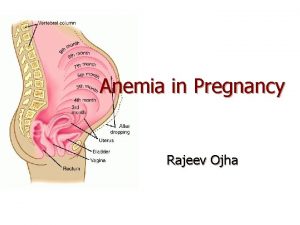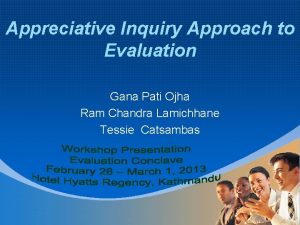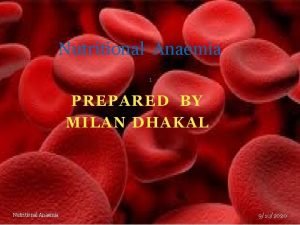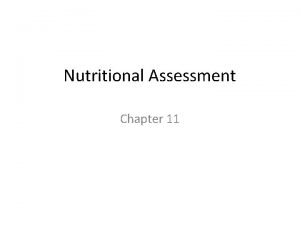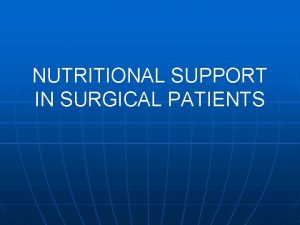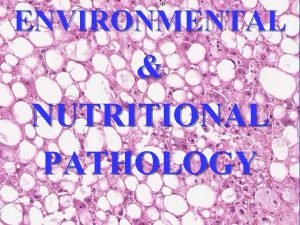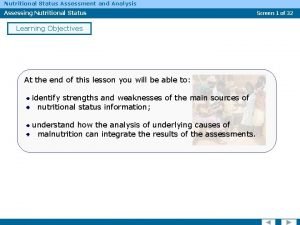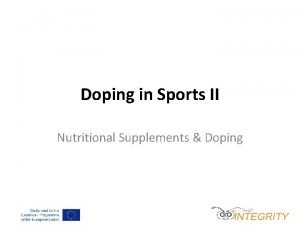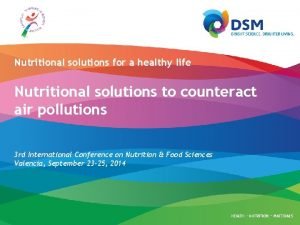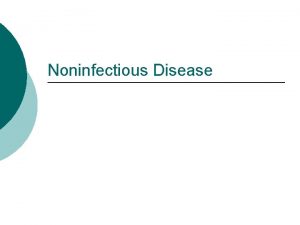Nutritional Disorders in Children Dr Nisha Ojha Associate








































- Slides: 40

Nutritional Disorders in Children Dr. Nisha Ojha Associate Professor PG Department of Balroga NIA, Jaipur

Nutritional Disorders in children (Kuposhan Janya Vyadhis) The follownig may be categorised under Kuposhan janit vyadhis as per Ayurvedic classics • • • Krishata/Karshya Phakkaroga Parigarbhik Balshosh Sushkarevati

Krishata शषकसफ गदरगर व तवगसथ श ष त कश मत ॥ (C. S/Su/21/15) धमन ज लसनतत � सथलपरव नर i. e. in Atikrisha person or children the flanks, abdomen or neck region will be dried up. There will be visible arteries over the body. It seems that there are only skin and bones are remaining and at the same time the joints will look apparently larger in size.

Etiology of Krishata • • Ruksha annapan Upavash (not proper feeding in time) Vatic prakriti Trishna Hunger Vatadoshit and vairasy stanya paan Excessive kashay rasa sevan Chronic diseases

Principle of treatment • • • Bringhan chikitsa(CS/Su/21/16) Nidan parivarjan Bringhana therapy to the lactating mother Treatment of underlying causes Balanced diet to the children

Some compound drugs for Krishata 1. 2. 3. 4. 5. Vidarigandadhi churna(YR) Aswagandha grita(YR) Subarna yog (YR) Aravindasav (B. R) Lehana yogas i. e. Kalyanak grita, Brahmi grita, Samvardhan grita etc.


Clinical features of Parigarbhik • • Agnimandya Vamathu (nausea and vomiting) Tandra (drowsiness) Karshya (emaciation)vertigo Aruchi(poor appetite) Brama(vertigo) Kostha vriddhi (distention of the abdomen)

Treatment of parigarbhik Priniciple-1. Agnideepan is the main stay of treatment in Parigarbhik 2. Guru and Snigda bhojan after agnideepan. Compound drug 1. A Grita made with Pippali, Pippalimula, Chitrak, katuki etc. with Dahi, Kanji, Suramanda should be given. 2. Vidarikanda, Yava, Godum and Pippali churna mixed with ghee should be given. Balanced nutrition should be maintained by giving milk along with honey and adequate amount of sugar 3. Bhibhitak phalamajja, yastimadhu, Kakoli, Ksheer Kakolli should be boiled in goat’s milk and should be prescribed in parigarbhik patients.

Phakka Roga ब ल सवतसर पनन य नगचछत सफकक (Kashyap on Phakka chi. Adhyay) प द भय इत व जञय It means if the child remains incapable of walking independently even after attaining of one year age, that stage is called Fakka roga. This implies that after attaining one year of chronological age the child is unable to make a few independent steps, suggesting delayed development of motor system and pyramidal tract.

Nirukti of Phakka • फककत न चरगचछत इत फकक • The word ‘phakka’originates from the root ‘फक ‘which means ‘crawling movement', 'sluggish movements 'or ‘running down condition of the body. ’ • So it can be said that Phakka is a clinical condition where due to continuous deterioration of health the child fails to attain developmental milestones. Depending upon nirukti and definition it can be concluded that it is a symptom complex instead of a single disease.

Primary causes of Phakka • Child of lactating mother who is recently pregnant • Anatha shishu • Grahani roga • Excessive eating • Mandagni • Srota-avarodh • Excessive passage of urine and stool

Classification of Phakka is classified into 3 types • Ksheeraj • Garbhaja • Vyadhija

Ksheeraj phakka ध तर शलषम कदगध फककदगधत सजञ त ततकष रप बहवय ध फककतवम पनय त II ( Kashyap/pha. ch. adh/4) त I क रश त • Breast milk, vitiated by kapha dosa is called phakka dugda • Consumption of such type of vitiated breast milk, the child initially suffers from many diseases (Bahu Vyadhi), later on develops ‘Phakka’ due to emaciation. • The condition may precipitate the disorders like diarrhoea due to which the condition of the child further deteriorates and finally gets severely malnourished.


• A newly delivered women, if conceived in quick succession suffers from qualitative and quantitative deficiencies of her breast milk. The child becomes very weak if fed by such milk. • Poor spacing between pregnancies leads to early weaning and if it is without adequate weaning food, the child definitely will suffer from malnutrition. • Lack in exclusive breast feeding child will suffer from poor immunity as result there may be repeated infections and child will be further emaciated. • Early weaning may impact on emotional (neglect of child), contaminational, economical etc. problems which hand in malnutrition.



Pathogenesis of Vyadhija Phakka • When child is not taken care properly( anath shishu), may suffer from various diseases like fever, etc. Prolong suffering from exogenous and endogenous diseases may result in malnutrition. • Anath shishu may be victim of different problems • Probably due to poor socio-economic status and negligence they may not be able to prevent the diseases, hence more susceptible for diseases and later on gets severely malnourished.

Anatha Shishu Anath shishu may be victim of • child abuse, • neglect, • child labor, • poor nutrition, • psychological problems etc.

Features of Vyadhija Phakka o Loss of strength, lustre and muscle wasting o Buttocks, arms and thighs become lean o The abdomen and head looks relatively bigger, due to the emaciation of the other body parts o Eyes becomes yellowish and external body parts looks like skeleton

• Lower extremities becomes weak, resulting in slow and feeble movement. Therefore uses hand knees to move. • The severity of loss of movement incapacitates the child even to drive away the insects like house fly etc. Hence exists more contamination inviting secondary infections more easily. • Due to metabolic disturbance of the body, the hairs are subjected for either falling or erection, nails becomes big , polyuria and diarrhoea may be resulted.

• Foul smelling odour from child due to dirtiness • Child looks very irritable. • Pattern of respiration is changed i. e. laboured breathing may occur at last. • There is excess production of dhatu mala i. e. nasal secretions are increased. • At last child becomes totally apathic , dull of unconscious and seem to be died.

Comparison between Vyadhija Phakka , PEM and Rickets Features vyadhija Phakka PEM Marasmus + + 1. Irritability + 2. Muscle + wasting 3. Distended + + abdomen 4. Hair & nail Changes + + 5. Loss of subcutaneus fat + + 6. Associated + + Features like Anemia, infections etc. Rickets Kwashiorkor _ _ _ + _ _

Treatment of Phakka • Snehan &swedan-by Kalyanak Grita/ Satpal Grita/Amrita Grita for 7 days • Virechan by Tribrita Ksheer • Application of Brahmi Grita • After that child should be given milk medicated with Rasna, Yastimadhu, Punarnava, Satapuspa, Eranda, Draksha, Pilu, Tribrita etc. • Grita/Tail/ Yush/Milk/ Mansaras medicated with Rasna, , honey etc. should be given twice daily with rice of Sali Anna. • Treatment according to dosa predominance e. g. for kapha predominance Gumutra may given orally.

Physiotherapy in Phakka • Avyanga –patient should be massaged with Raj Tail. It can cure Bandhyalva and Pangutva • Practice of walking should be started with the help of specially prepared tricycle ( Tricakra Phakka Ratha)

Pathyapathya in phakka(Diet regimen) • Supplementation of diet is important factor in the management of Phakka. • The child should be offered especially meat soup, cereals and medicated milk for prompt relief.

BALSHOSH अतयह सवपन श त मबशलषम क सतनय सव न � श श कफन रदधष सर त स रसव ह ष॥ अर चक परत शय य जवर क सशच ज यत। कम र शषयत तत सन गध शकल मखकषण ॥ A. H/U/2/44 -45 Balshosh is a disease of children as described in classics, caused due to excessive sleep in day hours, excessive intake of cold water, excessive intake of Kapha vitiated breast milk and it is characterised by Arochaka (anorexia), Pratishyay ( rhinorrhoea), jwara ( fever), Kasha (cough), Snigdata and suklata of face and eye and ultimately leading to wasting of the children. So depending upon sign and symptoms the disease Balshosh

Samanya Nidan of Balshosh Dhatu kshaya causing factors They are well summarized in Charaka Samhita. These are • Pertaining to food habits Anashana (avoidance of food), ruksha (dry), alpa & pramita (low in quantity as well as in quality) diet intake, intake of ununctuous fluids • Environmental factors and habits. Facing strong air current or sunlight, excessive exercise, awakening in nights, excessive loss of feces, Rakta, Shukra & Kapha, Bhooto-upghata and Adana kala • Psychological factors-Fear, tension, grief etc Nidana of Shosha • Visham Bhojana (Improper and unbalanced diet) • Dhatu Kshaya (wasting of dhatus) • Sandharanama (suppression of natural urges) • Sahasa (work beyond one’s power)

Visista Nidan of Balshosh Ashtanga Samgrahakara describes Balshosha for first time with its specific etiology and pathology, clinical features and treatment. Thus the Nidana mentioned by Vagbhatta are vishishta to Balshosha. These are • Excessive sleep in day hours • Excessive intake of cold water • Excessive intake of Kapha vitiated breast milk

Pathogenesis of Balshosh • Due to obstruction to rasavaha srotas and ill formation of Rasa dhatu leads to anuloma Kshaya of the subsequent dhatus (tissues). The poor nutrition of tissues results in emaciation of the child leading to the Balshosha. • Due to the vishama / hina ahara (low calory/quantity/quality diet), the Jatharagni will get hina indhana for the pachanakriya. Ultimately the dhatvagnis will get low quality/quantity of indhana. After digesting the indhana(low quantity) the dhatvagnis will start the dhatupachana itself. Ultimately there will be Sarvadhatukshaya leading to Balshosha (Marasmus). • Due to causative factors there will be Kaphaprokop wich is further endagered by Balyavastha there will be mandagni and production of Amarasa wich may cause vaman, aruchi, atisar etc. leading to Rasakshay and Anulom kshay of Sarvadhatus and ultimately Balshosh will occur.

Clinical features of Balshosh Showing symptoms of Balshosha according to various Ayurvedic texts Symptom K. S. C. S. S. Arochaka - - - Pratishyaya - - Jwara - A. H. M. N. V. S. G. N. + + - - + + - - - + + - - - + + Snigdh netra - - - + + Shukla mukha - - - + + - - - + Shukla netra - - - + + - - - - - + - Kasa Shosha Snigdh mukha Shwas A. S. Sh. S.

Differential diagnosis Differentiating factor Nidana Rupa Balshosha Ksheeraja Phakka Three main causative factors are excessive day time sleep, excessive intake of cold water and feeding of Kapha vitiated breast milk Wasting(kumara shushyati tat) is the main feature with arochaka, kasa, jwara, pratishyaya etc. dhatu kshaya is the main feature causing wasting of total body Main causes are intake of Kapha vitiated breast milk and wasting due to other illness Types No types described Age affected Total childhood affected Main feature is inability to walk at the age of one year. There is weakness of snayu sansthan and dhatu kshaya is not the prime feature Is one of the three types of Phakka roga age may be Only infants are affected

Differentiating factor Balshosha Rajayakshma Nidana Three main causative factors Four main causative factors are excessive day time sleep, are Sahasa, Sandharana, excessive intake of cold water Kshaya Vishamashana and feeding of Kapha vitiated breast milk Purvarupa No prodromal described Rupa Wasting(kumara shushyati tat) is the main feature with arochaka, kasa, jwara, pratishyaya etc. Divided into trirupa, shadarupa and ekadasha rupa on the basis of presence of clinical features Type of Dhatukshaya Anuloma kshaya only Both anuloma and pratiloma Kshaya Age affected Only childhood age is affected Any age group can be affected Sankramakata (communicability) Non- communicable Is an infective & communicable disease features Pratishyaya, excessive sneezing, shleshma praseka, mukha madhurya etc.

Principle of treatment of Balshosh • • Nidanaparivarjan Srotoshodhan (Vaman etc. ) Dosasaman (Deepan, Paachan, Kaphasaman) Nutrition to the Dhatus(Balya, Bringhaniya, Rasayan therapy)

Drug treatment of Balshosha Vagbhat mentioned following yoga for the management of Balshosh. The following drugs are powdered, mixed with honey and ghrita. • Saindhava, Trikatu, Sharangeshta, Patha, Maha Kadamba. This is quite useful for anorexia in an emaciated child. • Powder of Ashok, kutki, Panchkola mixed with ghrita can be given for anorexia and emaciation. • Suspension of powder of Bera, flowers of Dhai and Amalki churna mixed with ghee can be given to the child. • Powder of Pippali, Trikatu, Patha, Murva, Shatavri mixed with honey • Payashya, Prithakparni mixed with honey and ghee • He mentions the use of Shishu shoshnashak shodhana ghrita, Shishu shoshjit ghrita, Shoshnashak oil and Lakshadi Tail for Balshosha.


Features of Suska Revati Sn. no Features of Shuska Revati Koch’s abdomen 1. The child passes loose greenish stool, sometimes of various colours + 2. The abdomen present nodular feelings and appearance of prominent veins over it + 3. The child becomes gradually emaciated + 4. Associated featuresi. fall of hairs ii. aversion from food iii. weak voice iv. discolouration v. excessive cry + + +/_

Treatment of Shuska Revati • Treatment of Skand Grah(except Dhupan for Skanda) • Udvartan with Vacha, Aswagandha, Hingu and Sarsap churna • Lepan-with fecal matter of crow, vulture and donkey. • Dhupan with Shalyak, Kulir Kapal, Meshasringi and nail and hairs of goat, elephant and donkey • Snan and Bali-snan should be done under dried tree and at the same time Bali of Masha, Madya and Shuska Mamsa should be offered under that tree.

THANKS
 Dhirendra ojha
Dhirendra ojha Roopesh ojha
Roopesh ojha Dr nisha patel
Dr nisha patel Nisha singh md
Nisha singh md Nisha nagarajan
Nisha nagarajan Nisha patel md
Nisha patel md Nisha patel family feud
Nisha patel family feud Nisha patel md
Nisha patel md Nisha rughwani
Nisha rughwani Name of technique
Name of technique Nisha patel md
Nisha patel md Kosten tio hbo
Kosten tio hbo What is incose
What is incose Ruckus certified partner
Ruckus certified partner Cipd
Cipd Imeche associate membership
Imeche associate membership Aad program
Aad program برنامهxx
برنامهxx Associate consulting engineers
Associate consulting engineers Associate program
Associate program Safety associate
Safety associate Promotion from associate professor to professor
Promotion from associate professor to professor What is an associate director
What is an associate director Advantages and disadvantages of direct mapping cache
Advantages and disadvantages of direct mapping cache Name something you associate with superman
Name something you associate with superman To associate
To associate Los angeles harbor city college
Los angeles harbor city college Associate degree rmit
Associate degree rmit Jeannie watkins
Jeannie watkins Associate consultant in capgemini
Associate consultant in capgemini Memorandum of association meaning
Memorandum of association meaning Tecniche associate al pensiero computazionale:
Tecniche associate al pensiero computazionale: Associate warden
Associate warden Harper college international students
Harper college international students Cern hid
Cern hid Child development matrix
Child development matrix Hea associate fellowship
Hea associate fellowship Critical thinking is an active process of discovery
Critical thinking is an active process of discovery Adobe spark certificate
Adobe spark certificate Rcog cpd
Rcog cpd Lone star college nursing program deadlines
Lone star college nursing program deadlines

